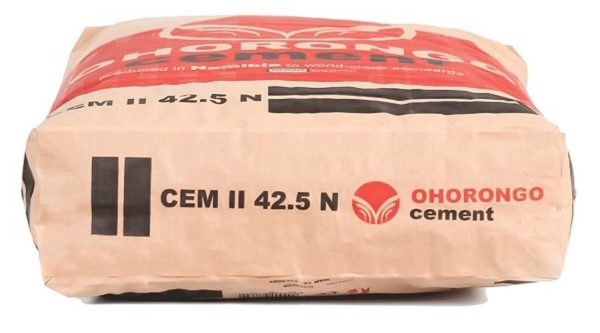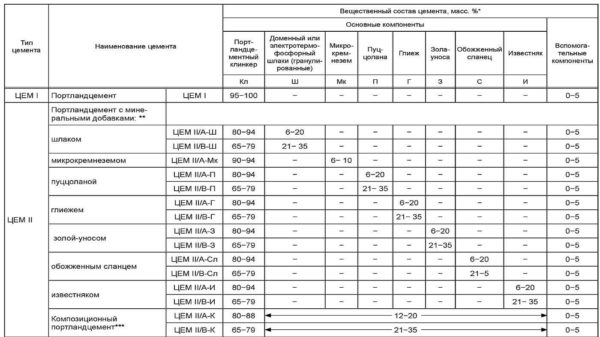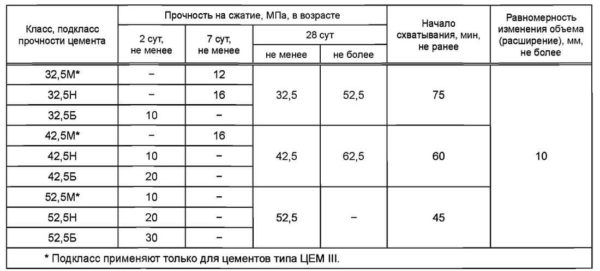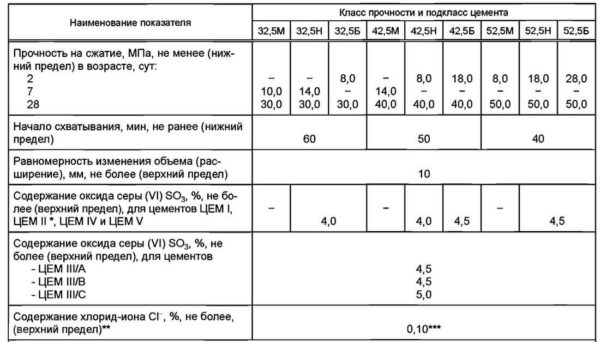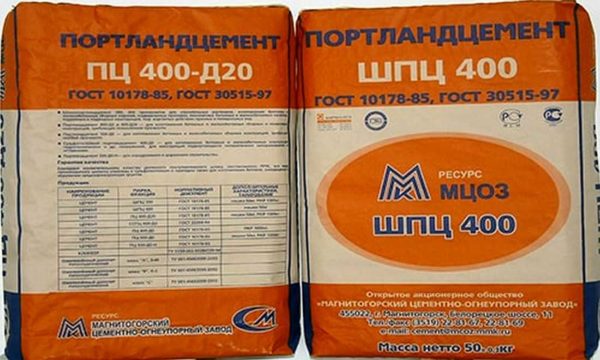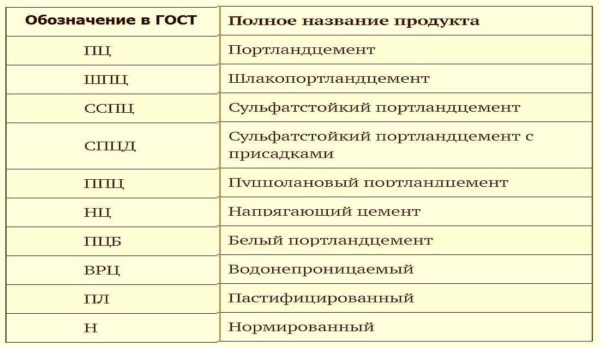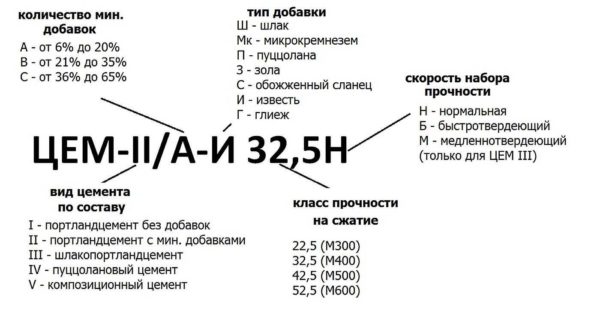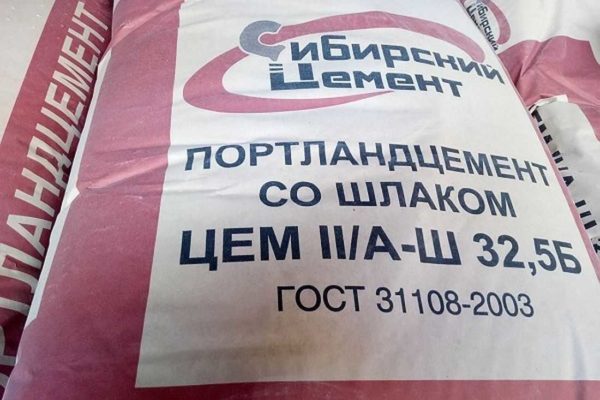Cement grades - marking according to the old and new state standards (GOST)
For more than fifteen years, a standard has been in effect that more fully describes the composition and characteristics of cement. According to the new standard, cement grades are indicated by Roman numerals, as well as the amount and type of additives, compressive strength class and hardening rate. In general, the new labeling contains complete information for an informed choice of binder.
The content of the article
Cement grades according to GOST 31108
The new standard was developed in 2003 to harmonize the current labeling with that adopted in the EU countries. At the moment, the latest version from 2016 is operational. As usual, the previous standard has not been reversed - both work in parallel.
Name and material composition
In a new way, cement grades are determined by their material composition. The marking contains three Cyrillic letters - ЦЕМ and Latin numbers behind them. The composition is encoded in Latin numbers and encrypted:
- The abbreviation CEM I stands for Portland cement. There can be no additives in it. It consists only of ground fired clinker and technological additives in an amount of not more than 5% by weight.
- CEM II - Portland cement with mineral additives. Mass fraction of additives - from 6% to 35%. By the number of additives, it is divided into two groups:
- group A with a content of 6% to 20%;
- group B says that the additives are from 21% to 35%.
- If you see CEM III - this is Portland slag cement. This grade contains from 36% to 65% slag ground into dust. By the number of additives, there are three subtypes:
- A - from 6% to 20%;
- B - from 21% to 35%;
- C - from 36% to 65%.
- Pozzolanic cement is designated CEM IV. It is a volcanic additive. It is usually produced in those places where this mineral is mined.
- Marking of composite cement CEM V. This grade of cement can contain several types of additives: slag, ash and limestone.
Cements from CEM II to CEM V can have subtypes depending on the additives. They are denoted by the Latin letters A, B and C. After the group designation, they put a slash, followed by a letter indicating the type of additive, then through a dash the letter that encodes the additive itself. For example, TSEM N / A-I. If there are several additives, their designation is indicated through a dash, and the entire group is taken in brackets: for example: CEM IV / A (P-Z-Mk).
Additives in the composition
Additives and designation of concrete grades with them are in the table. As you can see, CEM I is made only from crushed clinker with a small amount (no more than 5%) of technological substances. The second group of Portland cement has the most modifications and varieties.
Slag Portland cement and lower grades of cement also have additives, but the variations are much less. All additives and additives in the labeling are shown in capital letters:
- W - granulated slags;
- Mk - microsilica;
- P - pozzolana;
- G - glezh;
- З - ash;
- C - burnt shale;
- And - limestone.
Pure Portland cement - CEM I, always comes without additional components, since, by definition, it cannot have them. Consider a few examples of marking other brands of cement. If we see CEM II / V-Sh. This means that we have before us Portland cement of the second type, that is, with additives. This is indicated by the letters after the slash. The letter "B" says that the amount of additives is more than 21%, and the letter "W" - slag is used. The inscription CEM III / C denotes Portland slag cement with the addition of burnt shale.In general, the way of decoding the marking is probably clear.
Compressive strength class
In the new standard, the composition should indicate the compressive strength that this brand of cement is able to give. According to GOST, there are only three values:
- 22.5 H;
- 32.5 H;
- 42.5 H;
- 52.5 N.
Strength is checked on days 2, 7 and 28. Almost all cements are checked 7 days after mixing, and CEM III (slag Portland cement) is checked after 2 days. According to the speed of hardening, the grade of cement can be:
- normally hardened - denoted by the letter H after the compressive strength class;
- slow-hardening - M;
- fast-hardening - B.
All this information is displayed in the label. For example: CEM III / V-SH 32.5M. Designates slag Portland cement with B-type additives - granular slag, compressive strength 32.5 M, slow-hardening.
What does the cement brand mean according to the old GOST
There are more types of cement in the old standard. All of them are shown in the table. The most popular two brands are SHPC and PC. Accordingly, slag Portland cement and conventional. The marking is simple - there is a three-digit number after the abbreviation. This is a brand that indicates compressive strength in kilograms per square centimeter (kg / cm²). For example, PC 400, SHPC 300, PC 500. PC 550, 600 and 700 are much less common and used. They are used for special construction conditions.
In the labeling of Portland cement, the letter "D" stands behind the brand, which stands for "additives" and then a number from 0 to 20. The number indicates the percentage of additives, respectively, D0 is no additives, D20 - 20%. Granular blast-furnace slag is usually used as an additive. For example, PC 400 D15. It says that there are 15% slag additives in the cement.
By definition, there is more slag in the SPC. According to GOST, it contains from 21% to 85% of this substance and therefore the SPC cannot withstand more than 300 kg / cm². This is the cheapest brand of cement from the existing ones, which is used for the manufacture of low-grade concrete - M100, 150 or 200. And then, if you look at the recommendations, for the preparation of a solution brand M200 cement M400 is recommended, and permissible grades are M300 and M500. Nevertheless, Portland slag cement is used in everyday life - for screed, if its high strength is not required, for pouring concrete preparation when installing a floor on the ground.
In private households, the most popular cement grade is PC 400. It is optimal in terms of strength. From this cement, you can make a mortar from M200 to M350. It is these brands that are most widely used. Higher ones are used for multi-storey and special construction.
Correspondence between old and new cement marking
There can be no exact match, since the new standard provides a more complete decoding of the composition. It can only be compared in terms of strength and total number of additives.
If we compare the number of additives, we see the following picture.
- Those PC brands that have a zero amount of additives (D0) or no more than 5% of them correspond to a new cement brand - CEM I. That is, PC400 D0 to D5 and PC500 D0-D5 will both be labeled CEM I. But it will only stand further a different number that indicates the compressive strength class.
- All Portland cement produced according to the old standard with the amount of additives exceeding 5% will be classified as Type II under the new labeling. That is, PC 400 D10 or PC 500 D20 is equivalent to CEM II. Since according to the old GOST the amount of additives is not more than 20%, then all brands will belong to subtype A.
- Shlakoportland cement SHPC is re-designated as CEM III.
We figured out the correspondence of concrete types according to the old and new markings. In any case, with the most popular brands. And the correspondences between old brands and new ones in strength are as follows:
- M300 corresponds to 22.5 N;
- M400 - 32.5 N;
- M500 - 42.5 N;
- M600 - 52.5 N.
Now you can bring the exact correspondence between old and new cement brands using examples:
- PC400 D5 - CEM I 32.5
- PC400 D15 - CEM II / A-Sh 32.5
- PC500 D0 - CEM I 42.5
- PC500 D20 - CEM I / A-Sh 42.5
- SHPC 300 - CEM III 22.5
Not that hard. The new brands specify a more precise composition and quantity of additives that affect performance. The rate of hardening may also be indicated. In general, if you know the decryption, it is more convenient to select the desired brand.


